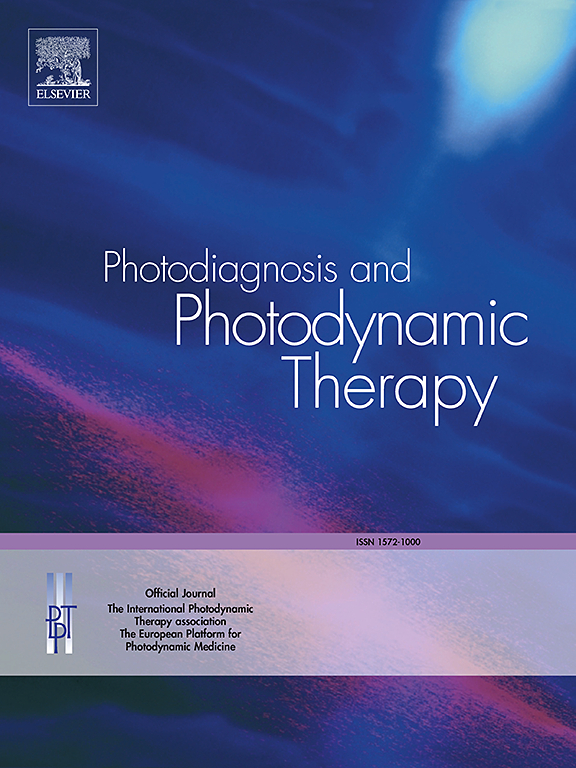通过核黄素介导的光动力疗法靶向HSV-1糖蛋白D:来自生物信息学分析和体外评估的见解。
IF 2.6
3区 医学
Q2 ONCOLOGY
引用次数: 0
摘要
简介:1型单纯疱疹病毒(HSV-1)在口腔粘膜和皮肤区域以及头部和颈部引起疼痛的病毒性病变。光动力疗法(PDT)通过靶向多种结构和分子有效地灭活HSV-1,而不会产生耐药菌株的风险。影响PDT抗病毒效果的最重要因素是所使用的光敏剂类型。因此,寻找更有效的光敏剂至关重要。本研究利用生物数据库和生物信息学工具研究了核黄素与发光二极管(LED)联合PDT对HSV-1的计算模拟、分子对接和体外抗病毒作用。材料与方法:用计算机方法预测并验证了HSV-1病毒附着蛋白糖蛋白D的三维结构。对该蛋白的理化性质和模型质量进行了评价。进行分子对接,随后测定核黄素的ADME/Tox谱、药代动力学性质和药物相似性特征。采用病毒滴定法和定量聚合酶链反应(qPCR)评估核黄素抗HSV-1 PDT后病毒载量的变化。结果:核黄素不违反利平斯基的五法则,这是一个广泛使用的指导方针,预测化合物在人体中口服活性的可能性。核黄素被列为毒性6级(极低毒),对肝脏无毒,无免疫毒性,也无细胞毒性。利用糖蛋白D与核黄素配体的三维模型进行分子对接研究,显示出良好的结合亲和力。此外,本研究的体外结果表明,led激活的核黄素可以有效抑制PDT期间HSV-1的复制,从而显著降低病毒载量(p结论:本研究结果表明,具有药物样特性的核黄素可以成功地与糖蛋白D结合,表现出很高的结合亲和力。此外,使用核黄素的PDT已被证明能有效抑制HSV-1的复制。因此,核黄素介导的PDT,通过降低病毒载量,成为一种有希望的补充治疗HSV-1。本文章由计算机程序翻译,如有差异,请以英文原文为准。
Targeting HSV-1 glycoprotein D through riboflavin-mediated photodynamic therapy: Insights from bioinformatics analysis and in vitro evaluation
Introduction
The herpes simplex virus type 1 (HSV-1) causes painful viral lesions in the mucosal and cutaneous areas of the oral cavity as well as the head and neck. photodynamic therapy (PDT) effectively inactivates HSV-1 by targeting multiple structures and molecules without the risk of developing resistant strains. The most significant factor influencing the antiviral efficacy of PDT is the type of photosensitizer used. Therefore, finding more effective photosensitizers is essential. This study utilizes biological databases and bioinformatics tools to investigate computational simulations, molecular docking, and the in vitro antiviral effects of PDT using riboflavin in combination with a light-emitting diode (LED) against HSV-1.
Materials and Methods
The three-dimensional structures of glycoprotein D, the viral attachment protein of HSV-1, were predicted and validated using in silico methods. The physicochemical properties of this protein and the quality of the model were assessed. Molecular docking was performed, followed by the determination of the ADME/Tox profile, pharmacokinetic properties, and drug-likeness characteristics of riboflavin. Changes in viral load following PDT using riboflavin against HSV-1 were assessed by a virus titration assay and quantitative polymerase chain reaction (qPCR).
Results
It was determined that riboflavin does not violate Lipinski’s Rule of Five as a widely used guideline that predicts the likelihood of a compound being orally active in humans. Riboflavin was classified as toxicity class 6 (very low toxicity) and was found to be non-toxic to the liver, non-immunotoxic, and non-cytotoxic. Molecular docking studies using the three-dimensional model of glycoprotein D with the riboflavin ligand showed good binding affinity. Additionally, the in vitro results of the study showed that LED-activated riboflavin effectively inhibits HSV-1 replication during PDT, resulting in a significant reduction in viral load (P<0.05).
Conclusion
The study’s findings indicate that riboflavin, possessing drug-like characteristics, can successfully engage with glycoprotein D, demonstrating a high binding affinity. Additionally, PDT using riboflavin has been shown to effectively suppress HSV-1 replication. Consequently, riboflavin-mediated PDT, by lowering viral load, emerges as a promising supplementary treatment for HSV-1.
求助全文
通过发布文献求助,成功后即可免费获取论文全文。
去求助
来源期刊

Photodiagnosis and Photodynamic Therapy
ONCOLOGY-
CiteScore
5.80
自引率
24.20%
发文量
509
审稿时长
50 days
期刊介绍:
Photodiagnosis and Photodynamic Therapy is an international journal for the dissemination of scientific knowledge and clinical developments of Photodiagnosis and Photodynamic Therapy in all medical specialties. The journal publishes original articles, review articles, case presentations, "how-to-do-it" articles, Letters to the Editor, short communications and relevant images with short descriptions. All submitted material is subject to a strict peer-review process.
 求助内容:
求助内容: 应助结果提醒方式:
应助结果提醒方式:


